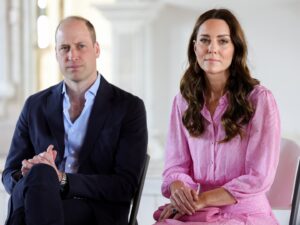In a rare public appearance, King Charles showcased his close relationship with Prince William and Kate Middleton, offering a glimpse into their familial bond.
The trio was spotted sharing light-hearted moments, with Kate bursting into laughter while chatting with her father-in-law.
Their visit to a Veterans Rehabilitation Center highlighted not only their commitment to community service but also the warmth that characterizes their interactions.
However, beneath the surface of this royal camaraderie lies a recent family disagreement that emerged just prior to the coronation.
Commentator Tom Quinn revealed that tensions were rising concerning young Prince George’s role in the historic event.
As the date approached, both William and Kate grew increasingly anxious about what would be expected of their son during such a significant occasion.
According to Quinn’s sources, a debate had sparked within the royal family regarding whether George should take on a more formal role at the coronation.
This concern echoes past experiences when William and Harry were thrust into the spotlight at a young age, particularly during their mother’s funeral.
Many criticized the decision to have the boys walk behind Princess Diana’s casket, believing it was an inappropriate burden for children to bear.
As discussions unfolded, it became evident that William and Kate were apprehensive about repeating history.
They questioned whether assigning George a role akin to that of a pageboy would be pushing the boundaries of tradition too far.
The weight of royal expectations can be heavy, especially for someone so young, and the couple was determined to protect their son from undue stress.
Despite these concerns, Prince George ultimately took on a pivotal role during his grandfather’s coronation on May 6, marking a significant milestone as the youngest future king to participate in such a ceremony.
His appointment as Page of Honor placed him front and center in the grand procession at Westminster Abbey, where he served alongside other pages.
George wasn’t alone in this monumental moment.
He was joined by Lord Oliver Cholmondeley, Nicholas Barclay, and Ralph Tallmash, all of whom attended to King Charles.
Meanwhile, Queen Camilla had her own support system, with her great-nephew Arthur Elliot and three grandsons—Gus Lopez, Louis Lopez, and Freddie Parker Bowles—by her side.
The presence of these young royals at the coronation not only symbolizes the continuity of the monarchy but also highlights the evolving dynamics within the royal family.
As they navigate their roles, the younger generation is learning to balance tradition with the need for a more modern approach.
Kate and William’s protective instincts toward George reflect a broader desire to shield their children from the pressures and scrutiny that come with royal life.
